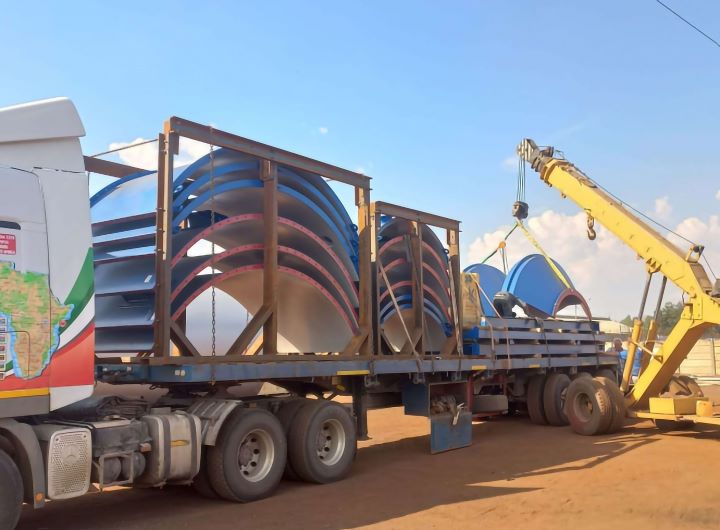
Hot dip galvanisers can contribute to the circular economy, moving away from the ‘take, make, dump and generate waste approach’ to one in which items are repurposed, conserving important resources and energy, says Robin Clarke, executive director of the Hot Dip Galvanisers Association of South Africa (HDGASA).
In South Africa, where many businesses are in survival mode, the concept of a circular economy is nevertheless gaining traction and – as a forward-thinking industry association, the HDGASA encourages members to embrace the important role that steel can play in this groundswell of sustainability, advises Clarke.
Steel takes a circular route
Referring to an article entitled ‘A bright future for hot dip galvanized steel in the circular economy’ by Bruno Dursin (published by the HDGASA following a presentation at INTERGALVA 2018), Clarke says it is time to move away from linear business models where products are manufactured from raw materials and discarded at the end of their (perceived) usefulness.
Dursin points out that the steel industry is already contributing to a circular economy. It is actively promoting and developing the use of high-strength and advanced high-strength steel grades which means less steel is needed to achieve the same strength and functionality.
Stepping up to sustainability
The role of hot dip galvanising contributes by further extending the service life of steel, says Clarke.
Hot dip galvanising controls the corrosion of carbon steel in two ways: it forms a barrier against the environment and – should this barrier be compromised – the remaining zinc forms an anode and provides cathodic protection to the steel substrate.
The thicker the galvanised coating, the greater the level of corrosion control and the longer the service life says Clarke: “When increasing the service life of carbon steel, two elements must be considered – the environment (the quality of the air, soil or water) and the thickness of the coating. In a relatively gentle or benign environment with modest levels of pollution and rainfall, a galvanised coating can provide a service life of over 80 years. In more aggressive environments, we need to look to guidelines from ISO 9225/3 and ISO 9224 to predict the service life – which can be between 15 and 25 years.”
In highly aggressive (corrosive) environments, the HDGASA recommends the use of duplex coating – a galvanised coating which is supplemented with a paint system – to extend the service life of a galvanised item.
Ideally, Clarke adds, buildings should be specifically designed for reuse, to the point where the same building can even be relocated.
“When you demolish a traditional building, you end up with a lot of rubble that cannot be repurposed. If you had a building largely constructed from steel, you would be able to reconfigure it differently – or design a building using elements which can be reused with minimal rework,” he suggests.
A great example is The Green House in Utrecht, The Netherlands, which was built as a temporary structure on land identified for reuse. The Green House is a ‘circular’ hotel / catering concept with conference facilities. This two-layer pavilion was designed as a generic-construction steel frame comprised of hot dip galvanised profiles, able to be disassembled and rebuilt at another site. The design’s agile ability to be relocated to another location is facilitated by a modular construction system which can easily be reassembled, featuring a steel main load-bearing construction. Thanks to a high degree of precision, steel components are easy to assemble and disassemble. The square grid design also facilitates multiple configurations and reconfigurations during repurposing.
A second good example is that of a temporary parking garage in Leiden, The Netherlands. Here a 410-square metre parking garage – constructed to meet Leiden’s long-term urban planning requirements – can be disassembled and all steel elements (columns, beams, cross-members cladding and fencing) are designed and selected for minimum maintenance – and ultimate repurposing – after a decade.
In South Africa too, Clarke reports that designers have become more forward-thinking: “People have always wanted corrosion control – but only in the context of the current project on which they are working. Now, they are thinking beyond the immediate return-on-investment and extending this to repurposing it for the next project – or even the one thereafter. They are specifying high levels of corrosion control to ensure that the steel is still in good enough condition to be used again.”
Zero-ing in on zinc
Clarke supports Dursin’s point that zinc, which is integral to the hot dip galvanizing process, can be recycled over and over without any loss in quality. It differs from many other synthetic materials, where recycling degrades their quality (‘down cycling’).
However, there are challenges in South Africa. Here, zinc ash or zinc dross, as by-products of the hot dip galvanizing process, are regarded as hazardous waste despite the fact that they can be recycled back to pure zinc – or into oxides which can be used to make tyres, fertiliser and medical products such as sun block and burn treatment creams.
Zinc-fortified fertilisers are particularly useful in parts of Africa where the soil is zinc-depleted and zinc-deficient crops do little to counteract malnutrition.
The HDGASA has assisted with an application to remove zinc-related wastes from the (hazardous waste) register two years ago – and is still awaiting an outcome.
Meanwhile, other changes are also gaining traction: “Locally, while some operations still rely on electricity generated using coal – there has been a concerted conversion to ‘greener’ natural gas, with approximately half of the country’s galvanisers having followed this route.
Overall, South Africa’s hot dip galvanising sector – like its counterparts globally – is now more efficient in capturing and controlling emissions, and ensuring that all chemicals, chemical elements and molten metals are managed in accordance with best practice,” Clarke concludes.
More news
- CELEBRATING EXCELLENCE IN THE RESIDENTIAL PROPERTY SECTOR
- PART 4: GIBS PANEL DISCUSSES INTEMEDIATE CITIES ROLE IN AFRICA’S DEVELOPMENT
- EXPOSED AGGREGATE PAVERS COMPLEMENT NEW LIFESTYLE CENTRE
- GIBS PANEL EXPLORES ROLE OF INTERMEDIATE CITIES IN SA’S DEVELOPMENT PART 3
- CITI-CON’S CONCRETE KNOWLEDGE SUCCESSFULLY DEPLOYED ON NEW LANDMARK DEVELOPMENT





